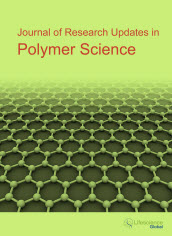jrups
Abstract : Degradation Kinetics and Mechanical Studies of Intumescent Coated Cotton Fabric
|
|
Abstract: In the present study, cotton fabric were prepared via coating with intumescent formulations of ammonium polyphosphate (APP), guanidine nitrate, penta erythritol (PER) and metal salts at different loading levels via ‘Pad-dry cure’ method. Thermal degradation behavior of prepared cotton derivatives was investigated by thermogravimetry (TG) and differential thermal analysis (DTA) from ambient temperature to 700 oC. Dynamic TG analysis was used to study the thermal degradation behavior of samples at four different heating rates of 2, 5, 10 and 20 oC min-1 in air atmosphere. The treated cotton fabric decomposes at lower temperatures and produces higher amount of char yields. The degradation activation energy was calculated using Friedman, modified Coats-Redfern and Ozawa-Flynn-Wall (O-F-W) iso-conversional model free methods. Tensile properties of coated fabric were found to be reduced with increase in loading of intumescent formulation but there was an abrupt increase in sample coated with intumescent and silica. With the insertion of iron (Fe) metal ion along with intumescent reduces the fabric strength due to formation of metal complexes with cotton cellulose which decreases the crosslinking. The maximum flame ratardancy of CF 12APP-Si among all cotton derivatives is suggested as the flame retardancy directly proportional to char yield (22 % at 650 oC) that is highest and inversely proportional to MMLR value (8.3 % min-1), that is least among all samples. Based on thermal and kinetic studies, the optimum concentration of flame retardant is worked out. Keywords: Model free kinetics,Thermal Analysis, CRA, Pad-Dry Cure, MMLR.Download Full Article |
Abstract : Covalent Functionalizations of Poly(vinyl chloride) in Tune with Applications: An Update
|
|
Abstract: Poly(vinyl chloride), PVC, stands as one of the best polymer candidates as far as polymeric materials are strongly sought for in our today’s life. Functionalization of poly(vinyl chloride) (PVC) remains an appropriate way to fashion materials for specific applications. Molecules of different functionalities and sizes, up to macromolecules, were affixed to PVC matrix. Graft polymerization led to functionalized PVC with several properties for different applications. Some covalently modified PVCs, mainly with heteroatom-containing and cyclic molecules, proved to be biologically active and efficient scaffolds for enzyme/protein immobilization. Suitable functionalizations of PVC even ensured the effectiveness of the polymers as separative, ion-selective electrode, and fuel cell membranes. Some modifying agents incorporated in PVC made the polymeric materials convenient and reliable for solar cells design. Reactions of PVC with metal chelating molecules engendered PVC-metal complexes that were efficient polymer-supported catalysts for Heck, Sonogashira, and Suzuki-Miyaura coupling reactions. Heavy metal sorbents were also made by tailored functionalization of PVC. Modifications of PVC with allotropic carbon nanoparticles, including fullerene C60, carbon nanotubes, and graphene and their applications in the nanocomposites making are herein discussed. The newly emerged “click chemistry” and “living controlled radical polymerization, LCRP” were exploited in the functionalization of poly(vinyl chloride). Keywords: Allotropic carbons, Applications, Functionalization, Membranes, Modification, Poly(vinyl chloride), PVC-supported catalysts.Download Full Article |
Abstract : 5-Hydroxy-6-Methyluracil as a Polyvinyl Chloride Stabilizer
|
|
Abstract: Kinetic regularities of thermooxidative dehydrochlorination of rigid and plasticized PVC in the presence of 5-hydroxy-6-methyluracil have been studied. The high antioxidant efficacy of 5-hydroxy-6-methyluracil in the process of polymer degradation has been revealed. It is shown that the studied uracil significantly slows down the process of accumulation of hydroperoxides in oxidation of dioctyl phthalate the plasticizer of PVC, which is the cause of a significant slowdown in the rate of decomposition of the plasticized polymer. Keywords: Polyvinyl chloride, thermooxidative dehydrochlorination, antioxidant, 5-hydroxy-6-methyluracil, low toxicity.Download Full Article |
Abstract : Carboxylated Magnetite Composite Polymer Nanoparticles with Mosaic Structure for Biomedical Application
|
|
Abstract: In this article, a microemulsion method for preparation of magnetite composite polymer nanoparticles of Fe3O4@poly(styrene-methacrylic acid) (MNP@PSMA) crosslinked with1,6-hexanediol diacrylate (HDD) insitu with carboxyl functionality on the surface has been reported. Structure and morphology of the nanoparticles was studied by Fourier Transform Infrared spctroscopy (FTIR), X ray Diffraction (XRD), Thermal Gravimetric Analyser (TGA), Vibrating Sample Magnetometer (VSM) and Transmission Electron Microscopy (TEM). VSM studies confirmed saturation magnetization of 20.0 emu/g in an external magnetic field. Nanoparticles formed were of 30 nm in diameter with narrow size distribution and mosaic structure providing a large surface area useful for application in bioseparation. Experimental results of covalent coupling of composite nanoparticles indicated maximum protein binding capacity of 350 mg bovine serum albumin (BSA) per gram. Keywords: Microemulsion, magnetic nanoparticle supports, protein separation.Download Full Article |






















